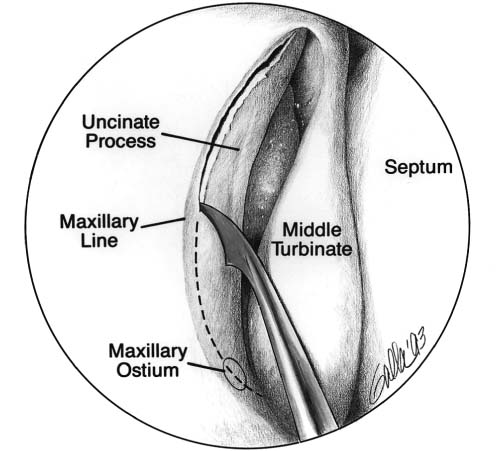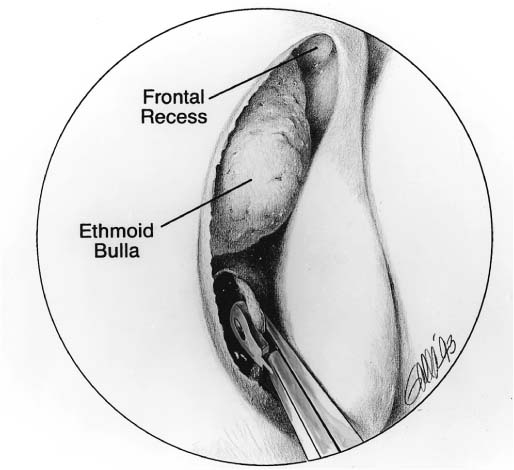22

Endoscopic Orbital Decompression
Graves’ disease is an autoimmune disorder that most commonly affects the thyroid gland and orbit. The term dysthyroid orbitopathy is used to describe the ocular manifestations of Graves’ disease, which include orbital congestion with enlargement of extraocular muscles and fat. This discrepancy between the volume of the bony orbit and its contents results in proptosis, which can have both cosmetic and vision-threatening consequences.
Dysthyroid orbitopathy appears to follow a clinical course independent of thyroid gland dysfunction or treatment. The severity and stage of the eye findings often bear little relation to the degree of the thyroid abnormalities. Thyroid gland treatment affects only one end-organ of this disease process and does not alter the fundamental autoimmune process causing the orbitopathy. Surprisingly, 10% of patients with dysthyroid orbitopathy display no endocrine function abnormality at any period throughout their life.
The initial acute phase of dysthyroid orbitopathy typically lasts 6 to 18 months and is associated with inflammation and congestion of the orbital contents.1 An increase in the volume of soft tissue leads to elevated intraorbital pressure, with a resultant anterior displacement of the globe. In severe cases, exposure keratitis, diplopia, and optic neuropathy with visual impairment can result. The typical progression of signs and symptoms has been described by the acronym NOSPECS (Table 22–1). Corticosteroids may be useful for the initial treatment of these inflammatory symptoms; however, the symptoms generally recur unless the steroids are continued long term. Low-dose irradiation with ~20 Gy can be effective in limiting the lymphocytic process leading to the orbital congestion and optic neuropathy.
A chronic, stable phase of dysthyroid orbitopathy occurs as much as 3 years after the onset of the orbital findings. Enlargement and fibrosis of the extraocular muscles and an increase in the amount of orbital fat are permanent changes that may require surgical therapy. Surgery is usually performed once the orbital process has stabilized. Surgical treatment includes strabismus repair for diplopia, eyelid adjustments for lid retraction, and orbital decompression for exophthalmos with optic neuropathy or exposure keratitis.
Surgical decompression of the orbit has traditionally been performed by the otolaryngologist through a transantral approach, known as the Walsh-Ogura procedure. A large maxillary antrostomy allows for removal of the entire orbital floor with preservation of the infraorbital nerve. The medial orbital wall is removed through a transantral ethmoidectomy. This approach can result in inferior globe displacement and is associated with the morbidity of a Caldwell-Luc procedure. Furthermore, limited visibility along the orbital apex and ethmoid roof can result in incomplete surgery or serious operative complications.
The endoscopic intranasal approach for orbital decompression has grown in popularity since it was introduced by Kennedy et al2 and Michel et al3 in the early 1990s. Over the past decade, its safety and efficacy for the treatment of dysthyroid orbitopathy have been clearly demonstrated. The endoscopic approach allows for reduction of proptosis in patients with Graves’ disease, while affording the surgeon excellent visualization and avoiding the need for an external or intraoral incision.
Class | Description |
0 | No signs or symptoms |
1 | Only signs (eyelid retraction, lid lag, edema) |
2 | Soft tissue signs and symptoms (e.g., resistance to retropulsion, injection) |
3 | Proptosis (mild, 21–23 mm; moderate, 24–27 mm; severe, >28 mm) |
4 | Extraocular muscle involvement (minimal to frozen globe) |
5 | Corneal involvement (superficial to necrosis and perforation) |
6 | Sight loss by optic neuropathy (visual field defects, color vision, acuity) |
 Surgical Technique
Surgical Technique
The patient is placed in a supine position on the operating table with the head slightly elevated. Packing soaked in a 4% cocaine solution is placed in the nasal cavity to initiate mucosal vasoconstriction.
CONTROVERSY
Cocaine is an excellent choice for the patient undergoing surgery under local or sedation type anesthetics because of its properties as a topical anesthetic and decongestant. However, when performing surgery under general anesthesia, HLL uses oxymetazoline to achieve vasoconstriction. The cost is less, and there is less chance of cocaine interaction with anesthetics and vasoconstrictors.
Both eyes are draped in the surgical field. If general anesthesia is used, the corneas are covered with protective shells. Under endoscopic visualization, submucosal injections of 1% lidocaine with epinephrine 1:100,000 are placed along the lateral nasal wall and middle turbinate. If a septal deviation precludes endoscopic access to the middle meatus region, a septoplasty is performed before the decompression.
Orbital decompression is begun with an incision in the uncinate process. This incision is made just posterior to the maxillary line, a bony eminence that extends from the anterior attachment of the middle turbinate to the root of the inferior turbinate (Fig. 22–1). The maxillary ostium should be generously enlarged to provide optimal exposure of the orbital floor and to prevent obstruction of the maxillary sinus by the decompressed globe. Bone is removed in a posterior direction to the level of the back wall of the sinus (Fig. 22–2). Anterior removal stops at the thick bone of the frontal process of the maxilla, which protects the nasolacrimal duct. The ostium is enlarged superiorly to the level of the orbital floor and inferiorly to the root of the inferior turbinate. A 30-degree endoscope is used to identify the infraorbital nerve along the roof of the sinus.
FIGURE 22–1 The uncinate process is incised just posterior to the maxillary line, an eminence that extends from the anterior attachment of the middle turbinate to the root of the inferior turbinate.
FIGURE 22–2 The maxillary sinus ostium is enlarged in a posterior direction until it is flush with the back wall of the sinus. A large ostium is necessary to optimize exposure and removal of the medial orbital floor.
CONTROVERSY
Although in theory the anterior and posterior ethmoid arteries should be identified in every endoscopic sphenoethmoidectomy, this is often difficult because the vessels are small or are covered in bone. Successful endoscopic ethmoidectomy can be performed without identification of these blood vessels.





